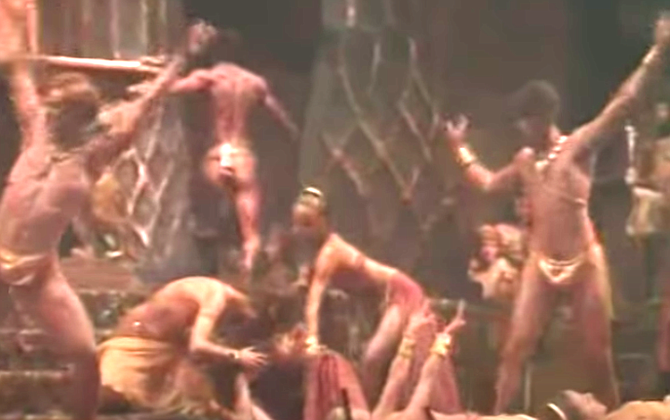 Facebook
Facebook
 X
X
 Instagram
Instagram
 TikTok
TikTok
 Youtube
Youtube

Lent came quickly this year. With no buildup to Carnival and Mardi Gras/Fat Tuesday, because of you know what, Ash Wednesday suddenly appeared. I thought we’d explore a few musical carnivals since the season didn’t exist this year.
Orchestre Philharmonique de Radio France Myung-Whun Chung
Carnival festivities can start anytime after the Christian celebration of Epiphany. Epiphany is on January 6. Most Carnival celebrations happen in February and March depending on when Lent starts. Lent is the 40 days before Easter and is symbolic of Jesus’ 40 days and nights in the wilderness before he started his ministry.
As an aside, 40 days and nights is a significant amount of time. I’m not sure what the significance is but in addition to Jesus, we have Budhha sitting under the Bodhi Tree for 40 days and nights. Buddha is tempted by the evil one at this time. There is Noah and the Ark with 40 days and nights of rain. Moses spent 40 days and nights on Mt. Sinai receiving the 10 Commandments, and Muhammed spent 40 days and nights in the cave before his first revelation.
Before the 40 days of Lent, during which time Christians are supposed to fast and give up worldly pleasures, most of Europe decided to get all the partying out of their systems during the Carnival season. This tradition started in the Middle Ages.
There is no official carnival music except for Hector Berlioz's Roman Carnival Overture. However, there are a few bacchanals that work quite well for capturing the spirit of Carnival and Mardis Gras. A bacchanal is a musical representation of a wine-soaked orgy presided over by the spirit of Bacchus.
It’s difficult to find an orgy these days since they go against so many Covid-19 protocols. We shall have to fulfill ourselves with musical representations.
Our first bacchanal is from Maurice Ravel’s Daphnis et Chloe. At the start of the ballet, youthful girls entice Daphnis with their dancing before the altar of the nymphs. Chloe is swept up into the dance and Daphnis approaches her “passionately” at the end.
Next is the Venusberg scene at the beginning of Richard Wagner’s Tannhäuser. The Venusberg is “The Mountain of Sex” in Tannhäuser. Tannhäuser has been spending his time reveling in the benefits of the flesh.
Tannhäuser was written about 70 years before Daphnis et Chloe. Wagner’s depiction with its swirling themes clearly influenced Ravel’s depiction.
Perhaps the greatest bacchanale ever written is from Camille Saint-Saëns Samson et Dalila. While Samson is held captive by the Philistines, they have a blood orgy before the god Dagon. The music has the same swirling and whirling themes but with an exoticism that is impossible to miss. The choreography helps drive the point home.
Now that we have assuaged the desires of the flesh, it's back to facemasks and social distancing and Lent.


Lent came quickly this year. With no buildup to Carnival and Mardi Gras/Fat Tuesday, because of you know what, Ash Wednesday suddenly appeared. I thought we’d explore a few musical carnivals since the season didn’t exist this year.
Orchestre Philharmonique de Radio France Myung-Whun Chung
Carnival festivities can start anytime after the Christian celebration of Epiphany. Epiphany is on January 6. Most Carnival celebrations happen in February and March depending on when Lent starts. Lent is the 40 days before Easter and is symbolic of Jesus’ 40 days and nights in the wilderness before he started his ministry.
As an aside, 40 days and nights is a significant amount of time. I’m not sure what the significance is but in addition to Jesus, we have Budhha sitting under the Bodhi Tree for 40 days and nights. Buddha is tempted by the evil one at this time. There is Noah and the Ark with 40 days and nights of rain. Moses spent 40 days and nights on Mt. Sinai receiving the 10 Commandments, and Muhammed spent 40 days and nights in the cave before his first revelation.
Before the 40 days of Lent, during which time Christians are supposed to fast and give up worldly pleasures, most of Europe decided to get all the partying out of their systems during the Carnival season. This tradition started in the Middle Ages.
There is no official carnival music except for Hector Berlioz's Roman Carnival Overture. However, there are a few bacchanals that work quite well for capturing the spirit of Carnival and Mardis Gras. A bacchanal is a musical representation of a wine-soaked orgy presided over by the spirit of Bacchus.
It’s difficult to find an orgy these days since they go against so many Covid-19 protocols. We shall have to fulfill ourselves with musical representations.
Our first bacchanal is from Maurice Ravel’s Daphnis et Chloe. At the start of the ballet, youthful girls entice Daphnis with their dancing before the altar of the nymphs. Chloe is swept up into the dance and Daphnis approaches her “passionately” at the end.
Next is the Venusberg scene at the beginning of Richard Wagner’s Tannhäuser. The Venusberg is “The Mountain of Sex” in Tannhäuser. Tannhäuser has been spending his time reveling in the benefits of the flesh.
Tannhäuser was written about 70 years before Daphnis et Chloe. Wagner’s depiction with its swirling themes clearly influenced Ravel’s depiction.
Perhaps the greatest bacchanale ever written is from Camille Saint-Saëns Samson et Dalila. While Samson is held captive by the Philistines, they have a blood orgy before the god Dagon. The music has the same swirling and whirling themes but with an exoticism that is impossible to miss. The choreography helps drive the point home.
Now that we have assuaged the desires of the flesh, it's back to facemasks and social distancing and Lent.
Comments